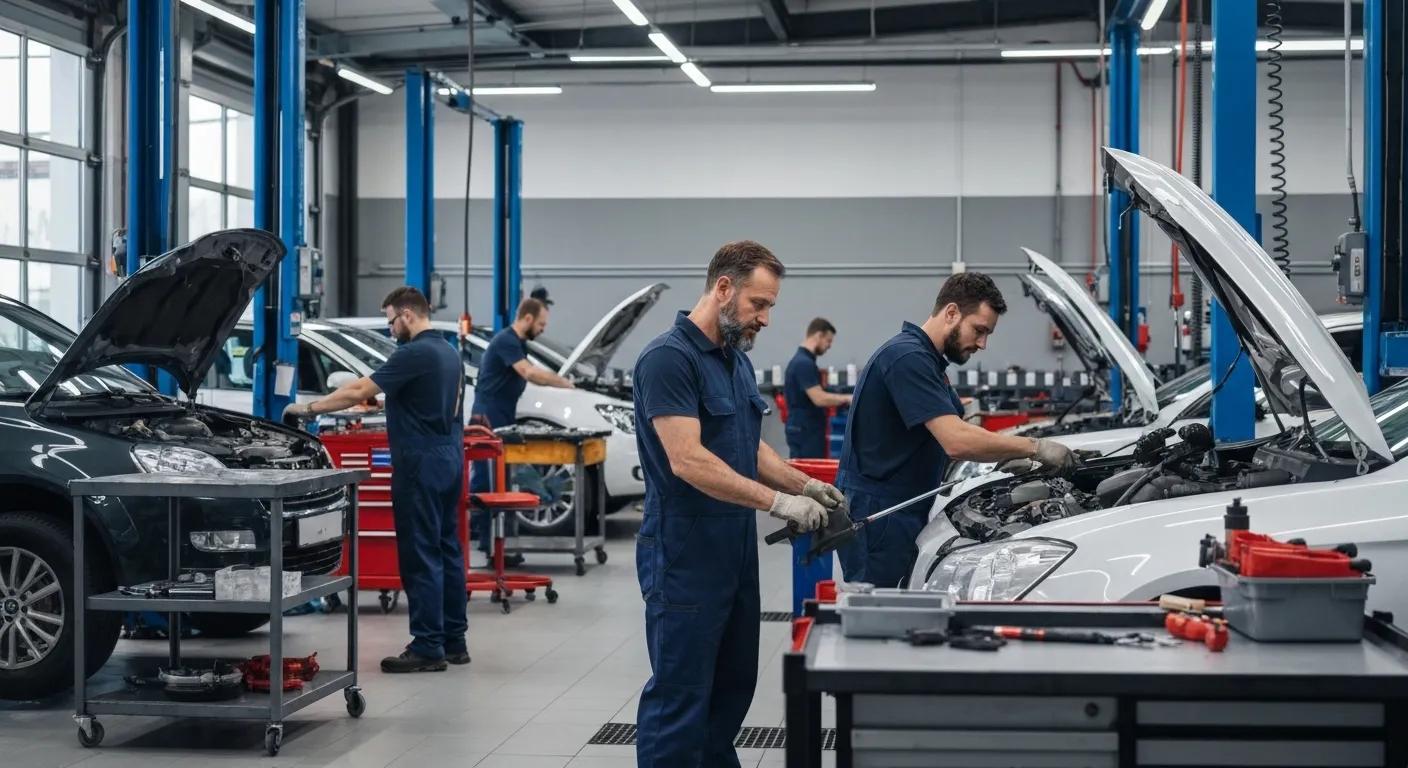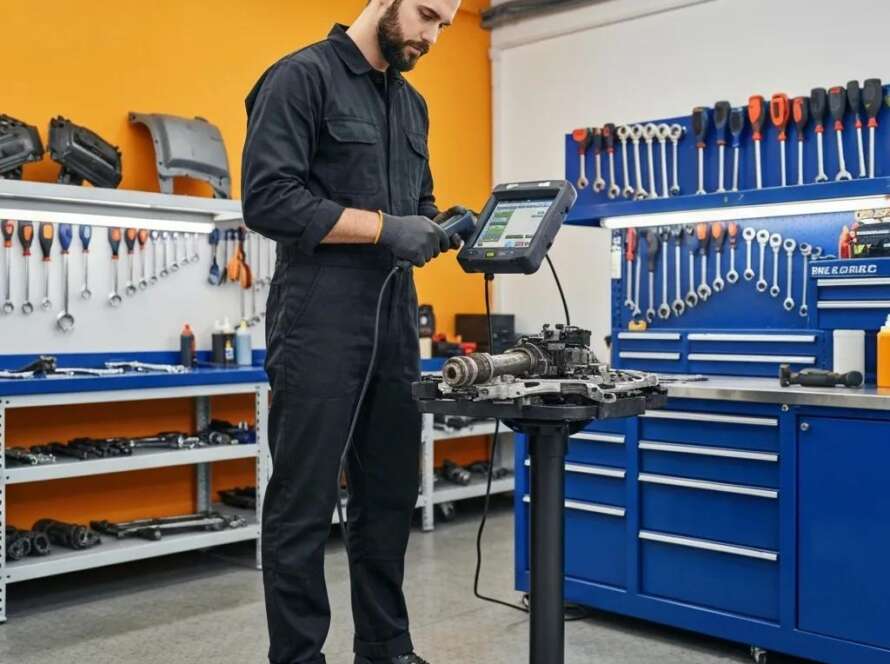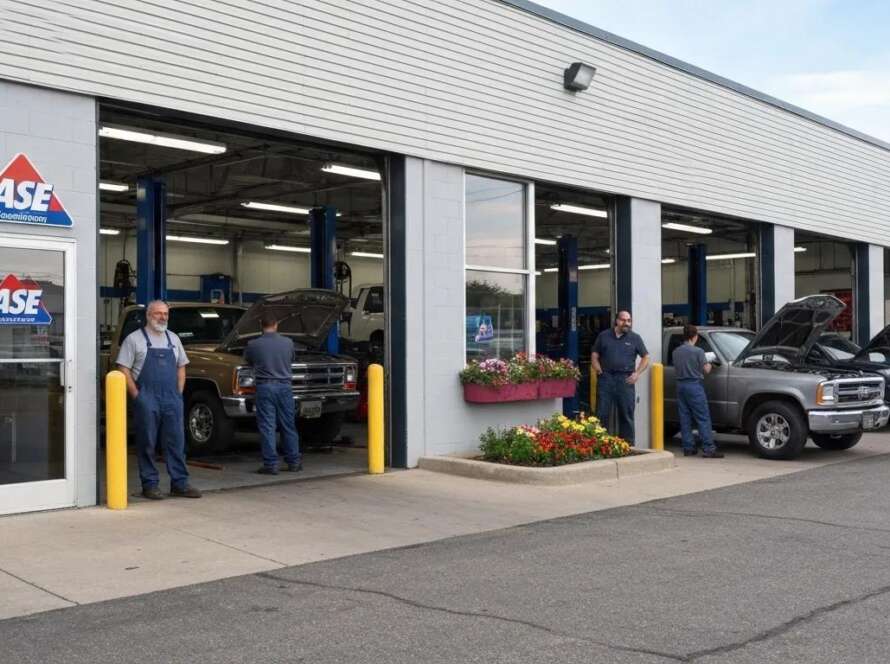
How to Decode Auto Repair Shop Reviews and Pick the Best One
Around 63% of drivers worry about being overcharged or receiving shoddy work, making online feedback an essential tool for finding a reliable auto repair shop.
Common Driver Worries About Auto Repair
A significant number of drivers voice concerns about unfair pricing and subpar workmanship at auto repair shops. This anxiety underscores the need for openness and accountability in the industry, which can be achieved through upfront pricing, detailed estimates, and clear, itemized invoices.
Consumer Reports, “Auto Repair Shops: How to Find a Good One” (2023)
This reference bolsters the article’s points about the importance of transparency and excellent customer service in the automotive repair sector.
In this guide, you’ll discover how to understand certifications, interpret review trends, demand clear pricing, assess warranty promises, and recognize outstanding customer service. We’ll delve into common scams, facility standards, local reputation, and readiness for new technology, empowering you to compare shops with confidence and sidestep costly mistakes.
Why Are Certifications and Qualifications Essential When Reviewing Auto Repair Shops?
Certifications and qualifications indicate that an auto repair shop employs technicians who meet industry benchmarks, leading to more accurate diagnostics and consistent repairs thanks to verified training and testing. For instance, a technician with a recognized credential is more likely to correctly identify engine issues, reducing the chance of recurring problems. Knowing which credentials matter sets the stage for evaluating other trust indicators in reviews.
What Does ASE Certification Signify About Your Mechanic’s Skills?
ASE certification confirms that a mechanic has successfully passed rigorous exams in critical areas like engine repair, brakes, and electrical systems, demonstrating specialized knowledge and practical proficiency. This credential helps prevent misdiagnoses by matching a technician’s abilities to the repair task, ultimately improving vehicle performance and customer trust.
The Value of Certifications in Auto Repair
ASE certification is a widely respected credential that validates a mechanic’s expertise across various automotive systems, including engine repair and electrical diagnostics. This certification aids in reducing misdiagnoses and enhancing vehicle performance, thereby boosting customer confidence in the repair process.
National Institute for Automotive Service Excellence (ASE)
This research supports the article’s focus on the critical role of certifications in ensuring high-quality auto repair services.
What Other Certifications and Affiliations Should You Look For?
Professional affiliations and accreditations beyond ASE further affirm a shop’s dedication to quality service.
- AAA Approved Auto Repair facilities meet stringent standards for equipment and technician training.
- Accreditation by the Better Business Bureau signifies a history of positive complaint resolution and ethical business practices.
- Manufacturer-specific certifications (e.g., for Honda, BMW) ensure technicians are well-versed in proprietary vehicle systems.
- National Institute for Automotive Service Excellence (ASE) Master Technician credentials indicate a high level of proficiency across multiple service disciplines.
These credentials collectively underscore a shop’s reliability and technical capabilities, guiding you toward highly qualified service providers.
How Do Certifications Influence Repair Quality and Customer Trust?
Certified shops consistently deliver accurate diagnoses, use genuine parts, and adhere to predictable service schedules, which typically results in positive customer feedback. When reviews frequently mention “certified technician” and “smooth repairs,” it’s a strong indication that standardized training directly correlates with dependable service and peace of mind.
With technician credentials established, the next step is to decipher online feedback patterns to confirm real-world performance.
How Can You Analyze Online Reviews Beyond Just the Star Ratings?
Analyzing reviews involves more than just looking at average star ratings; it means examining sentiment trends, review frequency, and the level of detail provided to understand a shop’s service consistency and responsiveness. For example, a collection of recent, detailed reviews praising the shop’s communication suggests active customer engagement and reliable follow-through.
What Review Patterns Signal Reliable or Problematic Shops?
The most revealing patterns emerge when you track review attributes across multiple entries:
| Platform | Attribute | Significance |
|---|---|---|
| Consistent 4–5 Stars | Indicates ongoing customer satisfaction | |
| Yelp | Detailed Feedback | Suggests reviewers invested time in their descriptions |
| Prompt Responses | Shows active management engagement | |
| Auto Forums | Technical Discussions | Reveals genuine expertise when readers discuss repair procedures |
Consistency in ratings and specific praise for quick turnaround times or fair billing practices are indicators of reliability, while widespread complaints about recurring issues often point to operational shortcomings.
How Do You Spot Red Flags and Fake Reviews in Auto Repair Feedback?
Fake or misleading reviews often share these common traits:
- Vague language lacking specific details about the repair.
- Numerous one-star or five-star reviews posted within a short timeframe.
- Reviews using similar phrasing across different user profiles.
- A lack of response from the shop when faced with negative feedback.
These signs suggest review manipulation or unresolved customer issues, so it’s best to avoid shops exhibiting them.
Why is a Shop’s Response to Reviews Crucial for Customer Service?
When a shop owner publicly addresses criticism or thanks customers for positive feedback, it demonstrates accountability and open communication. Engaged management uses negative feedback as an opportunity for improvement, reflecting a customer-focused culture that prioritizes satisfaction over short-term gains.
After assessing review authenticity and responsiveness, clear cost communication becomes the next critical factor in your decision-making process.
What Role Does Pricing Transparency Play in Auto Repair Reviews?
Pricing transparency means shops provide written estimates, itemized invoices, and clear explanations of labor and parts costs, which helps prevent unexpected charges and builds customer trust. A detailed estimate minimizes disputes and enhances satisfaction by setting accurate expectations before work commences.
Why Should You Insist on Written Estimates and Itemized Invoices?
A written estimate breaks down the cost of each service and part, allowing you to compare quotes objectively and manage your budget effectively:
- Itemized invoices detail labor hours, part numbers, and individual charges.
- Clear breakdowns enable you to verify fair market pricing and identify potential markups.
- Documentation serves as crucial evidence if you need to dispute a billing issue.
Itemized records establish accountability and provide a solid basis for comparing services.
How Can You Identify Hidden Fees and Overpriced Repairs?
Be aware of these common pitfalls in reviews and invoices:
- Diagnostic “packages” that add extra hourly charges without clear justification.
- Parts listed as “remanufactured” without upfront price details.
- Sudden upsells for additional services after the initial work has begun.
Identifying inflated costs early on helps protect your budget and prevents unwelcome surprises when you pick up your vehicle.
How Does Clear Communication from Technicians Affect Perceptions of Pricing?
When service advisors clearly explain the scope of repairs, parts options, and available alternatives, customers generally report higher satisfaction and fewer billing disagreements. Transparent communication demonstrates respect for your vehicle and your finances, fostering positive reviews and long-term trust.
After confirming cost clarity, warranty protections offer an additional layer of assurance when selecting your auto repair shop.
How Do Warranties and Guarantees Influence Your Choice of Auto Repair Shop?
Warranties and guarantees reflect a shop’s confidence in its workmanship by offering coverage for parts and labor over a specified period, thereby protecting you from repeat repair expenses. A robust warranty minimizes risk and signifies that a shop stands behind the quality of its service.
What Should You Understand About Parts and Labor Warranty Coverage?
Evaluate warranty details using this comparison:
| Coverage Type | Scope | Typical Duration |
|---|---|---|
| Manufacturer Parts | Integrity of OEM components | 12–24 months or 12,000–24,000 miles |
| Aftermarket Parts | Guarantee of functionality | 6–12 months or 6,000–12,000 miles |
| Labor Guarantee | Quality of workmanship | 90 days to 12 months |
| Combined Warranty | Coverage for both parts and labor | 6 months to 2 years |
How Do Warranties Reflect a Shop’s Confidence and Customer Protection?
Longer warranty periods suggest that a shop is confident in its parts suppliers and repair procedures, which reduces the likelihood of needing follow-up visits for the same issue. Customers often mention hassle-free warranty repairs, indicating strong internal quality control measures.
What Questions Should You Ask About Warranty Terms Before Authorizing Repairs?
Before approving any work, be sure to ask:
- What is the precise duration and mileage limit for this warranty?
- Are there any exclusions for wear-and-tear items like brakes or tires?
- How do I initiate a warranty claim if a problem reappears?
Clarifying these points protects your rights and prevents misunderstandings should subsequent work be necessary.
With warranty assurances in place, exceptional customer service provides the final piece of the puzzle in choosing the right repair partner.
Why is Customer Service a Key Factor in Auto Repair Shop Reviews?
Customer service encompasses clear explanations, courteous interactions, and proactive updates, all of which contribute to customer satisfaction and positive word-of-mouth referrals. Effective communication transforms a technical service into a supportive experience.
How Can You Assess the Communication Skills of Mechanics and Service Advisors?
Look for reviews that mention staff who “listened attentively,” “explained technical issues in simple terms,” or “provided regular progress updates.” These comments highlight active listening and empathy—hallmarks of trustworthy service.
What Does Excellent Customer Service Look Like in Reviews?
Examples of positive customer service include:
- Warm greetings and well-maintained waiting areas.
- Prompt callbacks when additional work is identified.
- Availability of courtesy shuttle services or loaner vehicles.
Each of these points reflects a shop’s commitment to customer convenience and respect for their time.
How Does Customer Service Impact the Overall Repair Experience?
When you feel understood and well-informed, you are more likely to trust cost estimates and accept recommended services, leading to smoother transactions. Satisfied customers tend to become repeat clients and often highlight these positive interactions in future reviews.
Next, recognizing deceptive practices will help you avoid dishonest shops that compromise service value.
What Are Common Red Flags and Scams to Watch Out For in Auto Repair Reviews?
Red flags such as unnecessary upselling, part swapping, and vague diagnostic reports can signal potential fraud, helping you steer clear of shops that prioritize profit over integrity.
What Are Typical Fraudulent Practices and Unnecessary Repairs?
Common scams include:
- Replacing functional parts without proper diagnostic confirmation.
- Charging for routine fluid checks as separate, additional services.
- Aggressively promoting fuel system cleans or engine flushes when they are not needed.
Identifying these tactics in reviews can help you avoid shops with unethical sales approaches.
How Can You Protect Yourself from Dishonest Mechanics?
Protective measures include:
- Seeking second opinions on major repairs from independent, reputable shops.
- Verifying part numbers and OEM labels on replaced components.
- Checking multiple customer feedback platforms for consistent complaints.
These steps help build a fact-based assessment of a shop’s reliability.
When Should You Get a Second Opinion on Auto Repairs?
If the estimated repair costs exceed 10–15 percent of your vehicle’s value, if the diagnosis is unclear, or if the proposed services seem urgent without any visible damage, it’s advisable to consult another certified technician. Second opinions help mitigate the risk of unnecessary expenses and ensure you receive appropriate solutions.
After identifying potential scams, evaluating the shop environment provides further insight into their service standards.
How Does the Shop Environment Influence Your Confidence in Auto Repair Services?
A clean, well-organized facility equipped with modern tools suggests efficient operations, which often translates into greater precision in service and more careful handling of customer vehicles.
Why is a Clean and Organized Facility Important?
A tidy workshop minimizes the risk of cross-contamination, lost parts, and errors, and it demonstrates pride in workmanship. When mechanics maintain a neat workspace, it indicates an attention to detail that carries over to the vehicle repairs themselves.
How Do Shop Conditions Reflect Technician Skill and Service Quality?
Well-maintained lifts, calibrated diagnostic equipment, and clearly labeled storage areas all point to a shop that invests in quality infrastructure. Reviews that praise up-to-date equipment suggest a shop is prepared to handle complex diagnostics and modern vehicle systems effectively.
What Should You Look for During an In-Person Shop Visit?
When visiting a shop, pay attention to:
- Clearly organized tool stations and inspection bays.
- Access to dealer-level diagnostic tools or OEM software.
- Adherence to safety protocols, such as spill containment and the use of protective gear.
These indicators highlight professional standards and reduce the likelihood of service shortcuts.
Evaluating facility standards naturally leads to considering community insights and personal recommendations, which further validate a shop’s reputation.
How Can Local Reputation and Personal Recommendations Guide Your Decision?
Referrals from friends and family, along with official ratings, complement online reviews by offering nuanced perspectives on service consistency and integrity based on multiple experiences.
How Do Word-of-Mouth Referrals Enhance Online Reviews?
Friends and family can share details about repair timelines, unexpected costs that were avoided, and the shop’s responsiveness in real-time, filling in gaps that static online comments might miss. Personal trust often stems from multiple direct experiences rather than isolated reviews.
Why Should You Check Consumer Protection Agencies Like the BBB Before Choosing?
Better Business Bureau ratings and complaint histories reveal how a shop handles customer disputes and whether recurring issues are reported. A high BBB accreditation score typically indicates fair business practices and consistent customer satisfaction over time.
How to Verify the Authenticity of a Local Auto Repair Shop’s Reputation?
Cross-reference the names of recommended shops across platforms like Google, Yelp, and Facebook to ensure consistent feedback. When multiple platforms highlight the same strengths or weaknesses, you can be confident that the pattern reflects genuine customer sentiment.
Beyond local feedback, consider how cutting-edge automotive technologies are changing repair complexity and customer expectations.
How Are Technological Advancements Reshaping Auto Repair and Reviews?
Advances in electric vehicles (EVs) and advanced driver-assistance systems (ADAS) require specialized diagnostic tools and enhanced technician training, aspects that reviewers often highlight when praising forward-thinking shops.
What Impact Do Electric Vehicles and ADAS Have on Repair Complexity?
EVs utilize high-voltage systems, battery management, and software updates, while ADAS components like cameras and radar sensors demand precise recalibration and software expertise. Specialized knowledge reduces repair time and ensures that safety features function correctly.
Why is Technician Training on Advanced Diagnostics Crucial?
Ongoing education in emerging technologies equips technicians to interpret complex fault codes, perform vehicle software updates, and conduct safe high-voltage work. Reviews that specifically mention “EV-certified mechanics” or “ADAS calibration expertise” highlight a shop’s commitment to future-ready services.
How Should Reviews Reflect a Shop’s Capability with Modern Vehicles?
Look for comments about successful software flashing, accurate sensor alignments, and error-free diagnostics for EVs and ADAS repairs. Positive feedback on these specific areas confirms that a shop is keeping pace with evolving vehicle technologies.
Approximately 63% of consumers express concerns about the trustworthiness of auto repair services, but with these insights, you can confidently navigate reviews and select a shop backed by certified expertise, transparent pricing, and solid warranty coverage. By understanding review sentiment, evaluating facility standards, and confirming community reputation, you can minimize risk and ensure high-quality service for both traditional vehicles and modern EVs or ADAS-equipped cars. Always remember to insist on written estimates, verify certifications, and ask clear warranty questions before authorizing any work. This structured approach empowers you to choose a repair partner dedicated to accountability, professionalism, and technical excellence.




